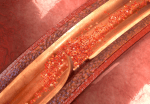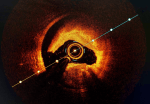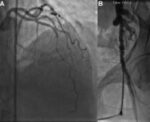Though rare, spontaneous coronary artery dissection (SCAD) might lead to MI, most commonly affecting young middle aged women. In these cases, the angiographic image will present a characteristic double lumen, and an intramural hematoma in the coronary artery wall. Normally, it will be treated medically. However, a small number of cases presenting STEMI will require...
Invasive vs Conservative Treatment in Patients with Spontaneous Coronary Artery Dissection
The prevalence of spontaneous coronary artery dissection (SCAD) is around 4% of acute coronary syndromes (ACS). Even though the current guidelines recommend a conservative approach, as long as it is clinically viable, it remain unclear whether there are benefits to percutaneous coronary intervention (PCI) as an initial approach, to prevent disease progression and adverse events....
Coronary Artery Dissection and Cardiogenic Shock: How Do They Evolve?
Spontaneous coronary artery dissections (SCD) are more frequent in women and account for about 25% of all acute myocardial infarctions (AMI) before the age of 50. While the presence of cardiogenic shock due to AMI is infrequent, its evolution is still somewhat unclear and it has not been fully analyzed. Researchers conducted an analysis in...
Spontaneous Coronary Artery Dissection: Are There Differences Between Men and Women?
Spontaneous coronary artery dissection is one of the causes of acute coronary syndrome, with a prevalence between 1 and 4%, that might reach up to 35% in women <50 years old, according to recent studies. As dissections are more frequent in women, research focuses on this population. Small retrospective studies have shown different triggers and predisposing...
Spontaneous Coronary Artery Dissection: Treatment and Prognosis
Spontaneous coronary artery dissection (SCAD) is a non-traumatic nor iatrogenic event that causes a separation of the coronary artery tissue due to an intimal tear or a mural spontaneous hemorrhage. This event is most frequent in young females and usually causes an acute myocardial infarction that could be major. It accounts for 1% to 4%...
Revascularization in Spontaneous Coronary Artery Dissection Causing ST-Segment Elevation Myocardial Infarction
Spontaneous coronary artery dissection is an increasing cause of acute myocardial infarction, particularly in younger women. These infarctions are frequently treated conservatively given the risks entailed by revascularization, due to the possibility of causing an antegrade or retrograde expansion of the dissection. The uncertainty around treatment for these patients gave way to this study (recently...
Coronary Artery Dissection in Women: Rare and Difficult to Manage
Courtesy of Dr. Carlos Fava. Spontaneous Coronary artery dissection (SCAD) was first described in 1931 and, even though its prevalence according to different studies is roughly between 0.07% and 1.1%, it is more frequent in women and is associated to acute coronary syndrome and sudden death. The study looked at 752,352 women presenting acute myocardial infarction (AMI)...
Pregnancy and Risk of Spontaneous Coronary Artery Dissection: How to Proceed
Courtesy of Dr. Pablo Baglioni. Between the years 2000 and 2015, the authors of this article searched for reports on spontaneous coronary artery dissection (SCAD) in pregnant or immediate post-partum women aiming at defining the clinical characteristics of this pathology and offering management recommendations. Information on 120 women was analyzed; 116 were between 22...
Spontaneous coronary artery dissection (SCAD) is associated with fibro-muscular dysplasia in other territories
Original title: Spontaneous Coronary Artery Dissection. Prevalence of Predisposing Conditions Including Fibromuscular Dysplasia in a Tertiary Center Cohort Reference: Jacqueline Saw, et al. J Am Coll Cardiol Intv 2013;6:44 –52 Non atherosclerotic spontaneous coronary artery dissection (Non atherosclerotic SCAD) is a rare disease that is associated with acute myocardial infarction and sudden death. This condition is more common...
Network Meta-Analysis of Complementary Imaging (IVUS/OCT + Conventional Angiography) for Coronary Stenting
Complementary imaging allows for the identification of numerous scenarios not visible with conventional angiography (ICA), both for the assessment of differential diagnoses and the improvement of percutaneous coronary intervention (PCI) outcomes. Advantages include assessment of plaque characteristics, vessel plaque burden, stent edge dissection, vessel diameter, and correct apposition, among others. While intravascular ultrasound (IVUS) was...





